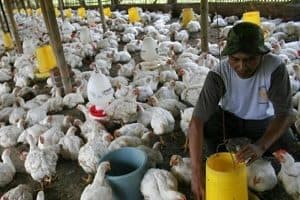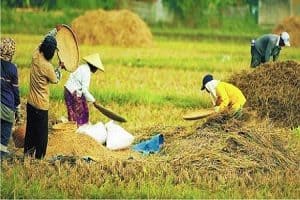Before learning about farming in Indonesia. Its a good thing to know about what is farming means first. Farming is an activity of exploiting biological resources by human to produce food, industrial raw material, or energy source, and to manage its environment.(Read also : Flag of Indonesia – Indonesia Military Power).
Biodiversity utilization activities included in agriculture are commonly understood as cultivation or crop cultivation as well as rearing of livestock (raising), although the scope may also be the utilization of microorganisms and bioenzymes in the processing of advanced products, such as cheese making and tempeh, or simply extraction, such as fishing or forest exploitation. (You might want to see : Balinese Wedding Traditions)
The largest share of the world’s population is livelihoods in fields in agriculture, but agriculture accounts for only 4% of the world’s GDP. The history of Indonesia since the colonial period until now can not be separated from the agricultural and plantation sectors, because these sectors have a very important meaning in determining the formation of various economic and social realities of society in various parts of Indonesia. (See also : Kecak Dance In Bali – Barong Dance in Bali)
Based on data from BPS in 2002, agriculture in Indonesia provides employment for approximately 44.3% of the population despite contributing only about 17.3% of total gross domestic product. (See also: Indonesian Angklung Facts)
History
Domestication of dogs is alleged to have been done even when humans are not familiar with cultivation (hunting and gathering) and are the first animal breeding and cultivation activities. In addition, forest utilization practices as a source of food are known to be the oldest agroecosystems. Utilization of forest as a garden begins with forest-based culture around the river. Gradually humans identify the trees and shrubs that are beneficial. Until finally man-made selection occurs by excluding poor species and varieties and choosing good ones. On the other hand, Agricultural activities (cultivation of crops and livestock) is one of the earliest known activities of human civilization and the total transformation of culture. (See also: Indonesian Theater – Indonesian Beliefs and Values)
Prehistoric experts generally agree that agriculture first developed about 12,000 years ago from cultures in the “fertile crescent” region of the Middle East, which includes the Tigris and Euphrates river basins extending westward to the present Syrian and Jordanian regions. The first evidence shows the existence of cultivation of grain crops (cereals, especially ancient wheat like emmers) and legumes in the area. (See also: Misunderstanding of Culture in Indonesia)
Farmers
In 2011, the International Labor Organization (ILO) stated that there are at least 1 billion more people working in the agricultural sector. Agriculture accounts for at least 70% of the number of child laborers, and in many countries a large number of women also work in this sector more than other sectors. Only the service sector is able to outperform the number of agricultural workers, ie in 2007. Between 1997 and 2007, the number of labor in agriculture fell and is a trend that will continue. The number of workers employed in agriculture varies across countries, ranging from 2% in developed countries such as the United States and Canada, to 80% in various African countries. (see also: Longest River in Indonesia)
In developed countries, this figure is significantly lower than in the previous century. In the 16th century, between 55 and 75 percent of Europeans work in agriculture. In the 19th century, this figure fell to between 35 and 65 percent. This figure now drops to less than 10%. (See also: Natural Disaster in Indonesia)
Crops Cultivation
Nutrition left on the ground after burning may support seasonal and chronic cultivation of plants for several years. Then the plot is abandoned for the forest to grow again and the farmer moves to the next forest plot to be used as a farm. The waiting time will be shorter when the farmer population increases, requiring nutritional input from manure and manure, and pest control. Seasonal cultivation develops from this culture. Farmers do not move, but require higher intensity of fertilizer input and pest control.
Read this too:
Cultivation Systems in Indonesia
 Rice fields, which is a form of agriculture done in wetlands and requires a lot of water both irrigated rice fields, rice fields lebak, rain-fed rice fields and tidal rice fields. Tegalan, which is an area with dry land that depends on rain water irrigation, planted with seasonal or annual crops and separated from the environment around the house. Land moor land is difficult to make irrigation irrigation because of uneven surface. During the dry season the dry field will be dry and difficult to be planted with agricultural crops.
Rice fields, which is a form of agriculture done in wetlands and requires a lot of water both irrigated rice fields, rice fields lebak, rain-fed rice fields and tidal rice fields. Tegalan, which is an area with dry land that depends on rain water irrigation, planted with seasonal or annual crops and separated from the environment around the house. Land moor land is difficult to make irrigation irrigation because of uneven surface. During the dry season the dry field will be dry and difficult to be planted with agricultural crops.
Then there is Yard or often called Pekarangan, which is a land that is in the environment within the house (usually fenced and into the home area) which is used for planting agricultural crops.
See also :
- Indonesian Martial Arts
- Indonesian Cultural Festival
- History of Borobudur Temple
- History of Chinese in Indonesia
1. Agroindustry
 Agroindustry is an activity that utilizes agricultural products as raw materials, designs and provides equipment and services for such activities. Explicitly the meaning of Agroindustry was first expressed by Austin (1981) ie a company that processes plant-based (plant-derived) or animal (produced by animals) vegetable materials.
Agroindustry is an activity that utilizes agricultural products as raw materials, designs and provides equipment and services for such activities. Explicitly the meaning of Agroindustry was first expressed by Austin (1981) ie a company that processes plant-based (plant-derived) or animal (produced by animals) vegetable materials.
The processes used include alteration and preservation through physical or chemical treatment, storage, packaging and distribution. This Agroindustry product can be finished product ready to be consumed or as product of other industrial raw materials.
Read also :
2. Animal Farms
 Animal Farming is an activity to breed and cultivate livestock to obtain the benefits and the results of these activities. The definition of animal farm is not limited to maintaining, and farming. The difference lies in the established purpose. The purpose of farming is to seek profit by applying management principles to optimally combined factors of production.
Animal Farming is an activity to breed and cultivate livestock to obtain the benefits and the results of these activities. The definition of animal farm is not limited to maintaining, and farming. The difference lies in the established purpose. The purpose of farming is to seek profit by applying management principles to optimally combined factors of production.
Based on the size of livestock, the field of livestock can be divided into two groups, namely large animal farms such as cattle, buffalo and horses, while the second group of small animal farms such as chickens, rabbits and others
Also read :
3. Types of livestock
 The types of livestock include cows, buffaloes, dairy cows, sheep, goats, pigs, rabbits, chickens, ducks, stakes, quail, silkworms, eels, green frogs, and bees honey. Each of these animals can be taken advantage of and the result. It depends on the farm itself. These livestock animals can be an option to be cultivated in accordance with the objectives to be achieved.
The types of livestock include cows, buffaloes, dairy cows, sheep, goats, pigs, rabbits, chickens, ducks, stakes, quail, silkworms, eels, green frogs, and bees honey. Each of these animals can be taken advantage of and the result. It depends on the farm itself. These livestock animals can be an option to be cultivated in accordance with the objectives to be achieved.
An agribusiness enterprise such as a livestock should have a purpose, which is useful as an evaluation of activities undertaken during breeding wrong or true. Examples of livestock purposes are commercial purposes as a means of obtaining profit. When this objective is established then all the principles of the firm’s economy, microeconomics and macro, accounting and management concepts must be applied.
Read also :
- Culture of Jakarta
- Culture of Sundanese
- Largest Ethnic Groups of Indonesia
- Traditional Indonesian Games
- Indonesian Wedding Culture
Special Farming Methods in Indonesia
 Each region has its own farming culture, South Central Timorese culture, in terms of raising livestock, most of the residents studied still have a tendency to let go of their pets in the grass during the day. Similarly in the Moluccas, livestock has not become a field that is occupied by the community. There are only ordinary farms in the absence of a particular system.
Each region has its own farming culture, South Central Timorese culture, in terms of raising livestock, most of the residents studied still have a tendency to let go of their pets in the grass during the day. Similarly in the Moluccas, livestock has not become a field that is occupied by the community. There are only ordinary farms in the absence of a particular system.
In general, the types of livestock are kept, including: goats, chickens and ducks. These animals are left free to roam without cages. In Lampung, livestock animals are allowed to roam freely, and after a few years later, they are captured and put in a cage, counted in number and marked on their bodies.
See also :
And the final object ending our study today about the farming in Indonesia. Indonesian must be proud, because Indonesia is one if the great producer of rice in the world. So that’s why many Indonesian really like to eat rice, beside giving respect to the farmers, the rice also taste delicious! Okay that’s it, have a great day !

